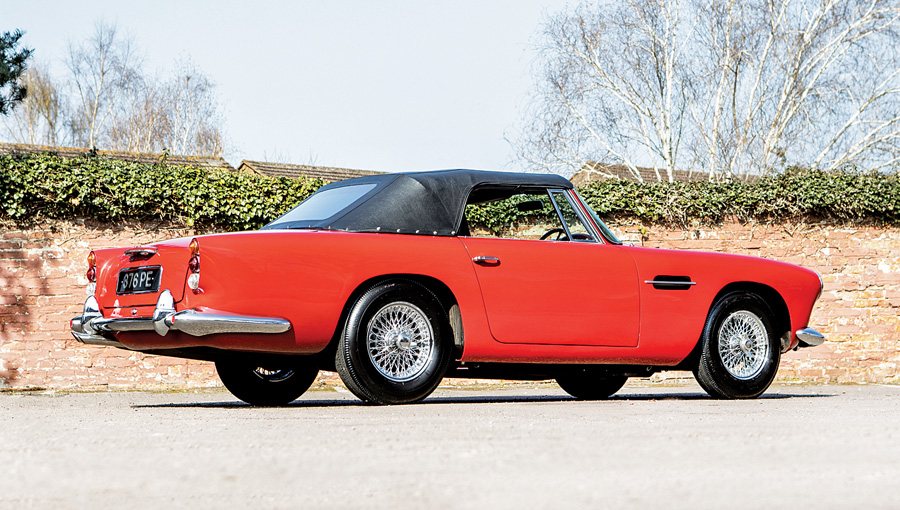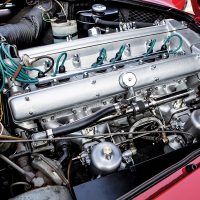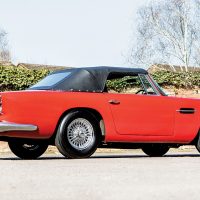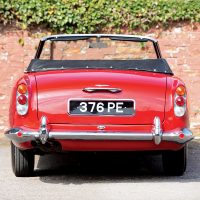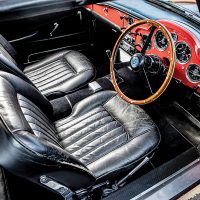SCM Analysis
Detailing
| Vehicle: | 1963 Aston Martin DB4 Convertible |
| Years Produced: | 1958–63 (convertibles 1961–63) |
| Number Produced: | 70 (30 SIVs, 40 SVs) out of 1,185 DB4s |
| Original List Price: | $11,250 |
| SCM Valuation: | $1,275,500 |
| Tune Up Cost: | $500 |
| Distributor Caps: | $81 |
| Chassis Number Location: | Plate on right side of scuttle |
| Engine Number Location: | On left of cylinder block next to alternator |
| Club Info: | Aston Martin Owners Club, Drayton St. Leonard, Oxfordshire OX10 7BG; +44 1865 400400 |
| Website: | http://www.amoc.org |
| Alternatives: | 1957–65 Maserati 3500 GT, 1962–65 Alfa Romeo 2600 Sprint, 1965–66 Ferrari 275 GTS |
| Investment Grade: | A |
This car, Lot 210, sold for $1,033,341 at Bonhams’ Aston Martin sale at the Wormsley Estate, U.K., on May 19 2019.
This was the star lot and catalog cover star at Bonhams’ annual Aston Martin sale. Although RM Sotheby’s has recently announced itself as Aston Martin’s “official auction partner” with a new marque-specific auction date in Monterey Car Week, Bonhams was doing it first — and this was its 20th edition.
Two years ago, it transpired that Aston Martin no longer had the room at Aston Martin Works on Tickford Street to host an auction, as it was building a new series of DB4GTs, so Bonhams piggybacked on to the Owners Club’s annual concours, last year at Englefield House in Berkshire and this time at the Wormsley Estate, a Getty-owned spread on the edge of the Chiltern Hills on the Oxfordshire/Buckinghamshire border overlooking the Thames Valley. This magnificent hideaway, which includes a polo field, is accessed by a mile-long driveway that would make a great hillclimb course — if you first removed the speed bumps.
A very rare DB4
Anyway, the car: Aside from the Zagato version, the DB4 convertible is Aston’s rarest DB-era road model, with fewer built even than the DB4 GT. Thirty Series IVs were built and 40 Series Vs, on a 3½-inch longer wheelbase and larger 15-inch wheels, the last stop in a continuing line of development before the DB5. This Series V was a lovely example combining originality, ongoing care and a little titivation. So it wore an older repaint in its original Fiesta Red dating presumably back to its early-’80s restoration, with the replacement leather now showing considerable wear since we last saw it at Buxton in June 2010, when H&H sold it for £297,000 (then $432,000). The engine, a replacement fitted by the factory Service Department before the car was delivered, had recently been rebuilt by Aston Martin Works, and it sat just right on tall Avon Turbospeed Mk4s — the right tire is so important to the stance and overall look of a car, and this approximates what it would have left Newport Pagnell on in 1963.
This is one of the first cars we’ve seen at auction to have Aston Martin Assured Provenance — a new program designed to “assess the originality, condition, and historical significance of the company’s Heritage cars,” or a Classiche for Astons, if you will. The process consists of:
- A bumper-to-bumper inspection of the car
- A build-specification comparison
- A road test and report to assess mechanical health; and a thorough assessment of the outcome of these inspections and the car’s provenance records by a committee of Aston Martin experts.
This process costs £10,000 plus local taxes, which means £12,000 ($15,350) in the U.K. For that, assuming the car is approved, the client receives the Assured Provenance Package consisting of a “richly illustrated” record book, a copy of the digital data collected on a memory stick, a pair of dash plaques, a pair of sill plaques and the Heritage Assured Provenance certificate — all contained in a hand-crafted presentation box.
The process includes a digital scan “to assess structural integrity.” Presumably, that means to check whether the chassis is straight and the wheels are in the right places and pointing in the right directions, but 3-D scanning the body must be a hilarious but rather pointless exercise on a car that was built from hand-rolled and beaten aluminium over a bent-tube frame 56 years ago. This car was awarded Gold Standard provenance, which is one notch down from the ultimate Platinum level.
Decent money in a slower market
Even though red isn’t a flattering color for a Superleggera Aston, it was its original hue and it reached £810,200, or just over $1m, which looked decent money in today’s market, and came 12 lots before Bonhams sold a DB5 for a strong $1.1m. Crucially, that means that the accepted high bid was right in the middle of the estimate range, in a time where we have gotten used to cars selling approximately 15% behind low estimate. That compares with $2,043,800 fetched by a 1965 DB Short-Chassis Volante (with hard top) at RM Sotheby’s Villa Erba sale the week after, which was well sold, no doubt helped by a change of color from its original … Fiesta Red.
Given that the DB5 is a development of the DB4, and the Short-Chassis Volante is really a DB5 instead of the differently constructed (and longer) DB6, that makes them almost the same thing.
Convertibles are always in fashion
It’s worth noting that convertible versions of most collectible classics — excepting E-types — are now worth around twice as much as coupes, and the DB4 falls into this category. When new, the convertible DB4 (£4,449, the price of a decent house) cost only £250 — 6% more than the hard top. Now the ratio is about two coupes to a convertible. Continuing that analogy, the value of a DB4 soft top today still buys you a rather nice house in the U.K., but the price of a coupe gets you only a fairly basic one.
Interestingly, an Aston Martin dealer who’d consigned many of the cars in the catalog had for sale at the time an almost identical example, though this was a Vantage (266 bhp), with Parchment instead of black leather, which had been the Works’ 1962 Earls Court Motor Show car. Its asking price was — and still is, as SCM went to press — £1.28m ($1.64m), or about 25% more than our subject car.
What he actually gets for it remains to be seen, but so far that’s three strong(ish) sales of top-end Astons in as many months, so perhaps the marque is bucking the general market trend and showing us the way up. ♦
